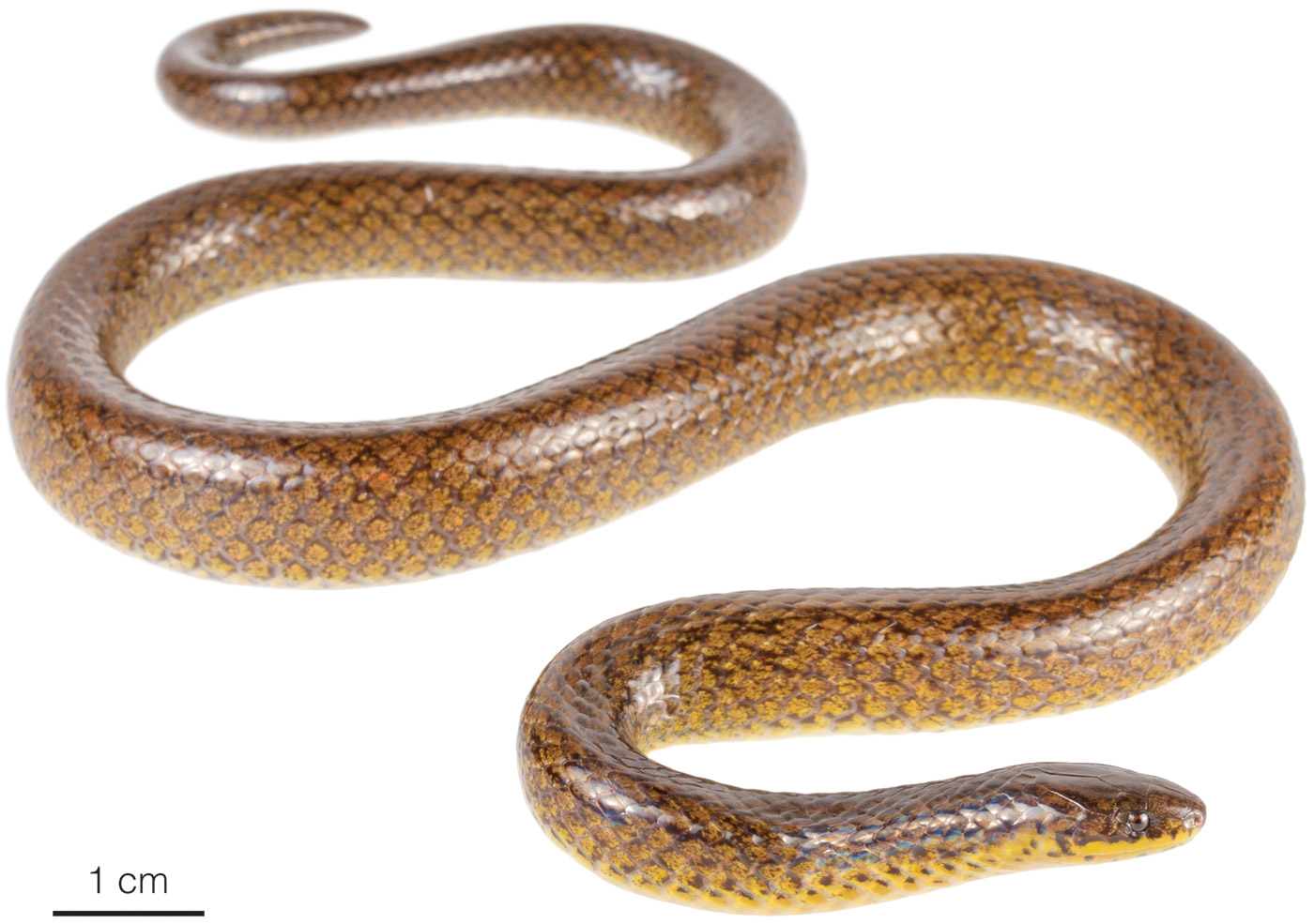Published March 22, 2021. Updated February 16, 2024. Open access. | Purchase book ❯ |
Cerberus Ground Snake (Atractus cerberus)
Reptiles of Ecuador | Serpentes | Colubridae | Atractus cerberus
English common name: Cerberus Ground Snake.
Spanish common name: Tierrera cancerbera.
Recognition: ♂♂ 34.5 cmMaximum distance from the snout to the tip of the tail. Snout–vent length=30.9 cm..1 Atractus cerberus differs from other snakes in its area of distribution by having a round head similar in width to the neck, small eyes, dorsal scales arranged in 17 rows at mid-body, no preocular scale, and a brownish, cryptic coloration.1 The dorsum is brown with or without five diffuse longitudinal dark lines (broken over most of dorsum) separated by pale interspaces, and a yellow-colored belly with small irregular dark spots (Fig. 1).1 This species differs from the morphologically similar A. esepe, A. iridescens, and A. microrhynchus by having a yellow, instead of white, belly and more than 150 ventral scales in males.1

Figure 1: Adult male individual of Atractus cerberus from Pacoche Lodge, Manabí province, Ecuador.
Natural history: Atractus cerberus is a rarely seen semi-fossorial snake known only from an isolated patch of seasonally dry lowland forest surrounded by dry lowland shrubland.1 This species inhabits an area where the mean annual temperature is 23.3–23.4ºC and where the mean annual precipitation is 255–260 mm.2 Cerberus Ground Snakes have been found active on soil or leaf-litter at night or during the early morning after a rainy night.1,3 Based on what is known about other ground snakes,4–6 the diet of this species probably includes earthworms and slugs. Atractus cerberus relies mostly on its cryptic coloration as a primary line of defense. If handled, individuals usually just try to flee, but they can also use their sharp tail-tip for poking.3
Conservation: Critically Endangered Considered to be facing imminent risk of extinction.. Atractus cerberus is listed in this category due to its small distribution range (only known from one locality) and the lack of records in other localities despite numerous surveys.1 Additionally, the species’ extent of occurrence is estimated to be less than 50 km2 and its habitat is severely fragmented, isolated from other forests, and declining in extent and quality due to deforestation.1
Distribution: Atractus cerberus is known only from the type locality, Pacoche, in the Ecuadorian province of Manabí (Fig. 2).

Figure 2: Distribution of Atractus cerberus in Ecuador. The star corresponds to the type locality: Pacoche, Manabí province, Ecuador.
Etymology: The name Atractus, which is a latinization of the Greek word άτρακτος (=spindle),7–9 probably refers to the fact that snakes of this genus have a uniform width throughout the body and a narrow tail, resembling an antique spindle used to spin fibers. The specific epithet cerberus is derived from the name of the Greek monster Kérberos. In Greek mythology, Kérberos is a monstrous multi-headed dog that guards the gates of the underworld, preventing the dead from leaving. The name refers to the type locality, at the gates of the newly formed “Refinería del Pacífico,” a massive industrial oil-processing plant that can easily be compared to the underworld.1
See it in the wild: Cerberus Ground Snakes are unlikely to be seen more than once every few weeks at the type locality, Pacoche, Manabí province. The snakes may be detected by scanning the forest floor and leaf-litter along trails at night.
Author: Duvan ZambranoaAffiliation: Universidad del Tolima, Ibagué, Colombia.
Editor: Alejandro ArteagabAffiliation: Fundación Khamai, Reserva Arlequín, Ecoruta Paseo del Quinde km 56, Santa Rosa de Mindo, Pichincha 171202, Ecuador.
Photographer: Alejandro ArteagabAffiliation: Fundación Khamai, Reserva Arlequín, Ecoruta Paseo del Quinde km 56, Santa Rosa de Mindo, Pichincha 171202, Ecuador.
How to cite? Zambrano D (2024) Cerberus Ground Snake (Atractus cerberus). In: Arteaga A, Bustamante L, Vieira J (Eds) Reptiles of Ecuador: Life in the middle of the world. Available from: www.reptilesofecuador.com. DOI: 10.47051/ZEGT1990
Literature cited:
- Arteaga A, Mebert K, Valencia JH, Cisneros-Heredia DF, Peñafiel N, Reyes-Puig C, Vieira-Fernandes JL, Guayasamin JM (2017) Molecular phylogeny of Atractus (Serpentes, Dipsadidae), with emphasis on Ecuadorian species and the description of three new taxa. ZooKeys 661: 91–123. DOI: 10.3897/zookeys.661.11224
- Mejía Guerrero MA (2018) Revisión taxonómica de las serpientes tierreras Atractus del grupo iridescens Arteaga et al. 2017. BSc thesis, Quito, Pontificia Universidad Católica del Ecuador, 67 pp.
- Field notes, Reptiles of Ecuador book project.
- Cisneros-Heredia DF (2005) Report of molluscivory in Atractus carrioni Parker, 1930. Herpetozoa 18: 185–186.
- Balestrin RL, Di-Bernardo M, Moreno AG (2007) Feeding ecology of the neotropical worm snake Atractus reticulatus in southern Brazil. The Herpetological Journal 17: 62–64.
- Melo-Sampaio PR, Passos P, Prudente ALC, Venegas PJ, Torres-Carvajal O (2021) Systematic review of the polychromatic ground snakes Atractus snethlageae complex reveals four new species from threatened environments. Journal of Zoological Systematics and Evolutionary Research 00: 1–30. DOI: 10.1111/jzs.12453
- Woodward SP, Tate R (1830) A manual of the Mollusca: being a treatise on recent and fossil shells. C. Lockwood and Company, London, 750 pp.
- Beekes R (2010) Etymological dictionary of Greek. Brill, Boston, 1808 pp.
- Duponchel P, Chevrolat L (1849) Atractus. In: d’Orbigny CD (Ed) Dictionnaire universel d’histoire naturelle. MM. Renard, Martinet et Cie., Paris, 312.